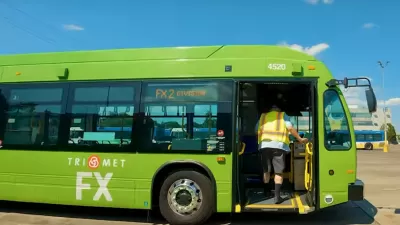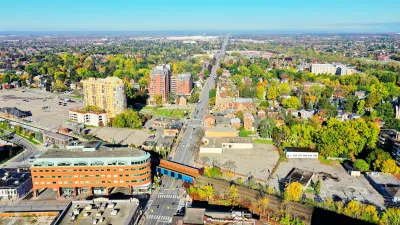Earlier this month, Portland’s TriMet restored high frequency bus service to ten bus routes around the city. Jarrett Walker makes the case that the frequency of service can make or break a city’s transit system.
“The reputation of Portland as a transit city in the last two decades may have been about its light rail, streetcar, or aerial tram, but to the extent that the city achieved significant ridership and made transit a welcomed part of urban life, it's done so with a grid of frequent transit services,” writes Jarrett Walker.
Ridership dropped on the TriMet system, however, after a 2009 reduction of service. “During the period of this service cut, as good connections enabled by the frequent grid became more arduous and wait times increased, the overall utility of the system across its strongest market was diminished. The impact on ridership was clear: between fall 2012 and fall 2013 alone, weekday bus ridership declined 3.6 percent, 2.6 on the MAX light rail system, continuing the negative trend starting from 2009.”
Earlier this month, however, TriMet restored 15-minute service to 10 critical bus routes. Walker argues that the high levels of service will benefit many aspects of the city, including TriMet’s ridership numbers: “The return of the grid is good news for riders, and no doubt the agency hopes to reverse the troubling ridership trend and create some good publicity in the [process]. High frequency transit service is a key characteristic of many of Portland's most attractive [neighborhoods], and must be seen as a permanent element of these places if they are to continue to grow in a manner that enables people to make real choices about their travel options.”
FULL STORY: portland: the high-frequency grid is back!

Planetizen Federal Action Tracker
A weekly monitor of how Trump’s orders and actions are impacting planners and planning in America.

Maui's Vacation Rental Debate Turns Ugly
Verbal attacks, misinformation campaigns and fistfights plague a high-stakes debate to convert thousands of vacation rentals into long-term housing.

Restaurant Patios Were a Pandemic Win — Why Were They so Hard to Keep?
Social distancing requirements and changes in travel patterns prompted cities to pilot new uses for street and sidewalk space. Then it got complicated.

In California Battle of Housing vs. Environment, Housing Just Won
A new state law significantly limits the power of CEQA, an environmental review law that served as a powerful tool for blocking new development.

Boulder Eliminates Parking Minimums Citywide
Officials estimate the cost of building a single underground parking space at up to $100,000.

Orange County, Florida Adopts Largest US “Sprawl Repair” Code
The ‘Orange Code’ seeks to rectify decades of sprawl-inducing, car-oriented development.
Urban Design for Planners 1: Software Tools
This six-course series explores essential urban design concepts using open source software and equips planners with the tools they need to participate fully in the urban design process.
Planning for Universal Design
Learn the tools for implementing Universal Design in planning regulations.
Heyer Gruel & Associates PA
JM Goldson LLC
Custer County Colorado
City of Camden Redevelopment Agency
City of Astoria
Transportation Research & Education Center (TREC) at Portland State University
Jefferson Parish Government
Camden Redevelopment Agency
City of Claremont





























